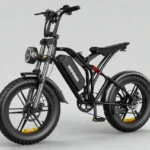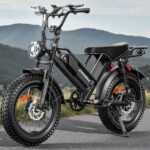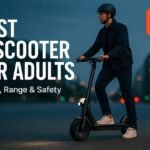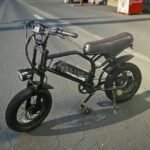![Best Electric Tricycles for Seniors: Safe, Comfortable Picks You Can Trust [year] Best Electric Tricycles for Seniors: Safe, Comfortable Picks You Can Trust](https://goebikelife.com/wp-content/uploads/2024/11/Best-Electric-Tricycles-for-Seniors.jpg)
Top 3 Electric Trikes for Seniors
Chosen for stability, braking feel, easy handling, and real-world convenience.
![Best Electric Tricycles for Seniors: Safe, Comfortable Picks You Can Trust [year] MOONCOOL TK1 electric trike (placeholder)](https://goebikelife.com/wp-content/uploads/2024/11/MOONCOOL-TK1.jpg)
MOONCOOL TK1
Safest-feeling ride • Hydraulic brakes • Signals
- Conservative top speed (~16 mph) keeps cornering calm.
- Hydraulic discs + parking brake = light lever effort.
- Rear differential for predictable, planted turns.
- Sine-wave controller = smooth, non-jerky starts.
- Folding frame; 20″ tires; integrated lights & turn signals.
Tip: start in PAS 1–2 and practice low-speed U-turns in a parking lot.
![Best Electric Tricycles for Seniors: Safe, Comfortable Picks You Can Trust [year] Meetone Breeze electric trike (placeholder)](https://goebikelife.com/wp-content/uploads/2024/11/Meetone-Breeze.jpg)
Meetone Breeze
Reverse gear • Differential • 20 mph headroom
- Reverse mode makes garages & elevators effortless.
- Rear differential reduces inside-wheel hop in turns.
- Folds for storage; options for bigger battery bundles.
- Comfortable upright cockpit with swept bars.
- Great for apartment riders who need maneuverability.
Safety first: brake before turns; coast through the corner.
![Best Electric Tricycles for Seniors: Safe, Comfortable Picks You Can Trust [year] NARRAK S180 electric trike (placeholder)](https://goebikelife.com/wp-content/uploads/2024/11/NARRAK-S180.jpg)
NARRAK S180
1,350W peak • Hydraulic brakes • Differential
- Confident hill starts with 750W nominal / 1350W peak.
- Hydraulic braking keeps lever effort low on descents.
- Rear differential stabilizes cornering with cargo.
- Folding frame simplifies storage & transport.
- 20 mph-class for mixed path / light road links.
Tip: use lower PAS on wet days to prevent wheel spin.
Finding the “just right” e-trike for a senior rider is all about confidence, comfort, and control—not chasing speed.
In this guide, I’ll walk you through what actually matters for safe, enjoyable riding (with plain-English checklists), and I’ll recommend five excellent models that fit different needs and budgets.
I’ll be decisive about who each trike is best for so you can pick with confidence.
TL;DR — Top Picks by Use Case
- Best overall comfort & stability: MOONCOOL TK1 — conservative top speed, hydraulic brakes, turn signals, differential, and a very senior-friendly ride feel.
- Best compact folder for small spaces: Meetone Breeze — folds quickly, reverse gear + differential, and a higher (but still reasonable) 20 mph cap.
- Best hill-climber power: NARRAK S180 — 750 W nominal with 1,350 W peak, hydraulic brakes, and differential for composed cornering.
- Best budget-friendly: Qlife Trike (Triker / Triker Plus) — approachable price with options from a modest 750 W peak version to a 1,200 W peak upgrade.
- Best long-range cargo: PUCKIPUPPY Husky (single/dual-battery) — dual-battery option with a marketed up to 110-mile range and hydraulic brakes. Great for errands.
Comparison at a Glance
| Model | Motor (nominal / peak) | Battery & Range (claimed) | Max Speed | Brakes | Differential | Folds |
|---|---|---|---|---|---|---|
| MOONCOOL TK1 | 500 W / 1000 W | 48 V 14.5 Ah • 35–70 mi | 16 mph | Hydraulic + parking brake | Yes | Yes |
| Meetone Breeze | Up to 1000 W peak | 48 V 15–30 Ah options • ~30–80 mi | 20 mph | Disc | Yes + reverse | Yes |
| NARRAK S180 | 750 W / 1350 W peak | 48 V 13 Ah (typical) | 20 mph | Hydraulic | Yes | Yes |
| Qlife Trike (family) | 750 W peak (Triker) or 1200 W peak (Plus) | 468 Wh • up to ~50 mi (Triker) or 48 V 13 Ah • up to ~65 mi (Plus) | 16–20 mph | Disc | Varies | Yes (select) |
| PUCKIPUPPY Husky | ~750 W (peak ~960 W) | 48 V 18 Ah (single) or 18 Ah + 15 Ah dual • up to 110 mi (dual) | 20 mph-class | Hydraulic | — | Yes |
Why the focus on differentials and hydraulic brakes? A differential lets rear wheels rotate at different speeds in turns (less scrub and tip risk). Hydraulic brakes reduce hand effort and stay consistent—both are confidence-builders for seniors.
How to Choose an Electric Trike for Seniors (What Matters Most)
1) Fit & posture first (not watts)
- Step-through height: the lower the better for easy mounting.
- Upright posture: swept bars and a supportive saddle reduce back/wrist load.
- Seat-to-bar reach: shorter is usually better for comfort and control.
Try this 2-minute home fit check:
- Stand over the frame: can you step through without tilting the trike?
- Sit with feet on the ground: can you flat-foot or ball-foot for starts?
- Hands on grips: are elbows slightly bent and shoulders relaxed?
2) Stability ingredients
- Rear differential + wide track: more predictable cornering.
- Conservative top speed: 15–16 mph is often safer than 20 mph. The TK1 caps at ~16 mph by design.
- Tire choice: 3.0–4.0″ tires add comfort and forgiveness on imperfect paths.
3) Braking feel & effort
- Hydraulic discs are ideal: strong power with light lever feel (TK1, S180, Husky).
- Parking brake: prevents roll-away on ramps and when loading groceries (TK1).
4) Motor & controller behavior
- Smooth over savage: gentle take-off (sine-wave controllers, cadence sensors) is senior-friendly. TK1 uses a sine-wave FOC controller.
- Power headroom for hills: If you have steep grades or carry cargo, the S180’s 1,350 W peak helps.
5) Battery & real-world range
- 14–15 Ah (≈700 Wh) is a sweet spot for most seniors.
- Expect half to two-thirds of best-case range if you lean on throttle. In third-party tests, TK1’s efficiency outperformed expectations at mixed power levels.
6) Safety & visibility essentials
- Integrated lighting + brake lights, ideally turn signals (TK1).
- Mirrors and a loud bell/horn for shared paths.
7) Convenience
- Folding frame helps with tight hallways and storage (TK1, Meetone, S180, Husky).
- Reverse gear is underrated (Meetone).
- Baskets: front + rear baskets make errands practical (TK1, Husky).
The Winners (Hands-On Style Summaries)
1) MOONCOOL TK1 — Best Overall for Seniors (Comfort, Control, Confidence)
If you’re buying for a parent or you want maximum peace of mind yourself, the TK1 is the easiest recommendation. It deliberately tops out around 16 mph, which sounds slow on paper but feels perfect on a trike—fast enough for errands and park loops, slow enough to keep cornering drama low. The hydraulic brakes bite with light finger effort, and the parking brake prevents roll-aways on ramps. The rear differential reduces inside-wheel hop in turns, the turn signals help on neighborhood streets, and the folding frame is apartment-friendly.
Specs that matter: 500 W motor (1000 W peak) paired with a 48 V 14.5 Ah battery, with a claimed 35–70-mile window depending on assist. A sine-wave FOC controller and 24-signal cadence sensor make the TK1’s take-off smooth rather than jumpy. In independent testing, its real-world efficiency has impressed reviewers, which backs up the calm-and-capable personality we want for senior riders.
Best for: seniors prioritizing stability and predictable handling, caregivers seeking a confident first trike, and anyone storing in tighter spaces.
Consider if: hills are moderate; you prefer safe-feeling speeds over zippiness.
Skip if: you need sustained 20 mph travel on open roads.
Headline features: folding frame, hydraulic brakes w/ parking brake, rear differential, integrated lighting with turn signals, 20″ tires, 450-lb load rating.
2) Meetone Breeze — Best Compact Folder (with Reverse & Differential)
The Breeze is the tinkerer’s folder: compact, reverse gear for back-and-fill maneuvers, and a rear differential for more planted turns. It’s also tuned for a higher 20 mph ceiling, which apartment-dwellers who also want faster greenway cruising may appreciate. Meetone markets peak 1000 W output; battery options vary by listing, commonly around 48 V 15 Ah (with bundles that can double capacity). Range claims span roughly 30–80 miles depending on configuration and usage; 450-lb load is commonly cited across listings.
Best for: riders who need a folding trike with a bit more speed headroom and appreciate the reverse convenience in garages/elevators.
Consider if: you’ll occasionally ride in 18–20 mph zones; you value spec flexibility (single/dual-battery packages).
Skip if: you prefer a strictly limited top speed for safety.
Nice touches: reverse mode, differential, folding frame, multiple battery package options.
3) NARRAK S180 — Best for Hilly Areas (Peak Power Champ)
The S180 leans into hill confidence with a 750 W motor peaking at 1,350 W, hydraulic brakes, folding frame, and a rear differential. Top speed is around 20 mph. In practice, that extra peak power is useful when starting on an incline or hauling groceries from a farmer’s market. 48 V 13 Ah battery packs are common, and the braking system is on the “serious” end for this class—another plus for senior riders.
Best for: neighborhoods with steep grades, heavier riders, or frequent cargo trips.
Consider if: you want faster acceleration but still value a differential and hydraulic brakes.
Skip if: you’re range-obsessed; look to the Husky dual-battery below.
4) Qlife Trike (Triker / Triker Plus) — Best Value Pick
Qlife offers two value-minded flavors that cover a lot of senior use cases:
- Triker (budget): 750 W peak motor, 468 Wh battery, claimed up to ~50 miles, and ~16 mph top speed—sensibly capped for calmer riding.
- Triker Plus (step-up): up to 1,200 W peak, 48 V 13 Ah battery with up to ~65 miles, and ~20 mph top speed.
Qlife’s store language also highlights a “premium trike” with up to 1200 W and 20 mph for smooth city use—useful context if you’re comparing trims.
Best for: seniors hunting value, shorter neighborhood rides, and first-time trike owners who want a gentle learning curve.
Consider if: you want budget now with room to upgrade battery/motor later (by choosing the Plus).
Skip if: you need hydraulic brakes or maximum stability features out of the box—then look at TK1/S180.
5) PUCKIPUPPY Husky — Best Long-Range Cargo (Dual-Battery)
The Husky is a utility specialist. The brand markets a 750 W hub with peak ~960 W and a dual-battery option (48 V 18 Ah + 15 Ah) advertised at up to ~110 miles. It also features hydraulic disc brakes and a folding frame, with beefy tires and large baskets—ideal for errands and carrying pet supplies or picnic gear. If you routinely ride beyond the park loop or want full-day range with assist, the Husky’s energy budget is compelling.
Best for: range-heavy days and cargo duty.
Consider if: you want fewer charging days and bigger baskets.
Skip if: you rarely ride more than 10–12 miles at a time—TK1 or Meetone may be more cost-efficient.
Buying Checklist (Print-Friendly)
Before purchase
- Path types: crushed gravel? curb cuts? any 8–10% neighborhood hills?
- Storage constraints: measure doorways, hallway turns, and elevator depth (folding helps).
- Hands & grip strength: prioritize hydraulic brakes.
- Visibility: lights, brake light, turn signals (TK1) if you’ll mix with traffic.
- Assembly support: look for 90–95% pre-assembled models or local shop help (Meetone lists ~90%).
First 3 rides
- Ride an empty parking lot first; practice U-turns and braking drills.
- Learn throttle feathering (if equipped) and parking brake use on slight slopes. TK1’s parking brake is especially helpful.
- Start with PAS 1–2; increase assist once steering feels automatic.
Upkeep
- Check tire pressure weekly; low PSI = sluggish steering and higher tip-risk in turns.
- Squeeze brakes: levers should feel firm and even (hydraulics self-adjust).
- Battery: store at ~50–70% if unused for >1 month; avoid heat.
Which Specs Actually Affect Senior Safety?
- Differential: Less tire scrub = more predictable turns at walking speeds. (TK1, S180, Meetone include it.)
- Hydraulic brakes: Stronger braking with less hand force. (TK1, S180, Husky.)
- Controller tuning: Sine-wave FOC (TK1) = smoother launches, fewer surprises.
- Conservative speed caps: TK1’s ~16 mph cap is a feature, not a bug, for seniors.
Fit & Comfort Guide (for Senior Bodies)
- Hips/knees: A true step-through frame keeps knees low and reduces hip rotation.
- Hands/arthritis: Grips with palm support and hydraulic brakes help.
- Back: Consider a saddle with a small backrest if sitting fully upright; keep bars high enough to avoid hunching.
- Vision/hearing: Add a mirror and run daytime lights even on bike paths.
Sizing tip: Most 20″-wheel trikes fit riders roughly 5’0″–6’2″. If you’re at either extreme, confirm seatpost length and handlebar reach with the seller before buying.
Budget & Value: What You Get at Each Tier
- $1,000–$1,400 (Budget): Cadence sensor, mechanical or basic hydraulic brakes, single battery, 16–20 mph. Qlife Triker fits here.
- $1,400–$1,900 (Mid): Better controllers, hydraulic brakes, folding, differential. TK1, Meetone, and S180 options commonly land here.
- $1,900+ (Utility/Range): Dual batteries, cargo upgrades, premium finishing. Husky dual-battery fits here.
Model-by-Model Deep Dives
MOONCOOL TK1 — The Calm, Capable Companion
| Preview | Product | Price | |
|---|---|---|---|
|
|
MOONCOOL Electric Tricycle for Adults, 20″ x 4″ Fat Tire Electric Trike, 48V 500W Motorized Electric… | $1,299.00 $1,099.00 | View on Amazon |
Why seniors love it: predictable handling, gentle take-off, and stop-anywhere braking.
Key gets: hydraulic discs with parking brake, turn signals, differential, foldable frame, 500 W motor (1000 W peak), 48 V 14.5 Ah, 35–70 mi claimed, ~16 mph top speed, 450 lb load.
Pros
- Confidence-first speed cap and ultra-smooth controller behavior.
- Great braking feel and safety add-ons (signals, parking brake).
- Third-party testing reports strong efficiency for the battery size.
Cons
- Not for riders who want sustained 20 mph commuting.
- Single-battery by default (still enough for most seniors).
Ideal rider: prefers easy steering over raw speed, rides mixed paths, values lights/turn signals.
Meetone Breeze — The Feature-Rich Folder with Reverse
| Preview | Product | Price | |
|---|---|---|---|
|
|
Meetone Breeze Folding Electric Tricycle for Adults, 1000W Electric Trike, 20MPH 100Miles 3 Wheel… | View on Amazon |
What stands out: a real reverse gear and a differential—rare and genuinely useful in parking lots and tight garages. Claimed peak 1000 W, 20 mph, and configurations around 48 V 15 Ah with optional dual-battery kits; 450-lb load is common across listings.
Pros
- Reverse and differential make it easy to live with day to day.
- 20 mph headroom suits mixed path/road usage.
- Options for bigger battery bundles and ~30–80 mi claimed range.
Cons
- Faster ceiling than TK1—great for some, but higher speed requires more rider discipline.
- Brake spec varies by listing; confirm hydraulic vs mechanical.
Ideal rider: apartment/condo owners who prize maneuverability and occasionally want 18–20 mph cruising.
NARRAK S180 — The Muscle Trike for Hills
| Preview | Product | Price | |
|---|---|---|---|
|
|
NARRAK Electric Tricycle for Adults,Fat Tire Folding Electric Trike,3 Wheels Electric Bicycle Bikes,… | $1,230.00 | View on Amazon |
With 750 W nominal and 1,350 W peak plus hydraulic brakes and a differential, the S180 is built for grades and payloads. A folding aluminum frame and ~20 mph top speed round out a very complete spec for hilly suburbs. Typical battery is 48 V 13 Ah; confirm options before purchase.
Pros
- Strong peak power for starts on inclines and heavier loads.
- Hydraulics and differential support stability when descending.
- Folding makes storage simpler.
Cons
- Higher power can tempt faster corner entries—ride within your comfort zone.
- Range is fine for daily use but not the longest here.
Ideal rider: must tackle steep hills or wants brisker acceleration without giving up stability features.
Qlife Trike Family — Wallet-Wise and Beginner-Friendly
| Preview | Product | Price | |
|---|---|---|---|
|
|
Qlife Triker Electric Bike, Peak 750W Brushless Motor Folding Trike Ebike, 468Wh Removable Battery,… | View on Amazon |
The Triker hits the price floor while staying practical: 750 W peak, 468 Wh battery, up to ~50 miles claimed, and a ~16 mph ceiling that keeps it approachable for first-timers. The Triker Plus bumps to ~1200 W peak, 48 V 13 Ah, up to ~65 miles, and ~20 mph for a still-affordable step-up.
Pros
- Low entry cost and a friendly learning curve (especially the 16 mph version).
- Upgrade path within the family (go “Plus” for more power/range).
Cons
- Brake and differential specs vary—confirm details on your exact trim.
- Value parts spec: fine for neighborhood rides, less plush than TK1/S180.
Ideal rider: budget-minded seniors, short-hop errands, flat to rolling neighborhoods.
PUCKIPUPPY Husky — Range King for Errands & Cargo
| Preview | Product | Price | |
|---|---|---|---|
|
|
Electric Trike for Adult with 960W Peak Motor, 48V 17.4AH Cells Battery, Pickup Class 500 LB Load… | $1,199.99 | View on Amazon |
The Husky’s calling card is energy capacity. The dual-battery setup (48 V 18 Ah + 15 Ah) is marketed at up to ~110 miles, with hydraulic brakes, folding frame, and serious cargo utility. If you want to do big-day rides with baskets full of groceries—or reduce charge frequency—this one’s compelling.
Pros
- Longest claimed range in the group with the dual pack.
- Hydraulic brakes and cargo-ready build.
Cons
- Heavier and pricier in dual-battery form.
- Overkill if your rides are 5–8 miles.
Ideal rider: range-focused seniors and dedicated errand-runners who want fewer charging sessions.
Safety Tips for New Senior Trike Riders
- Corner slower than you think. Enter at walking speed until the balance “clicks.”
- Brake before the turn, then coast through. Braking hard mid-corner can lift an inside wheel.
- Favor bike paths and quiet streets; run daytime lights and mirrors.
- Use the parking brake at loading zones, sloped driveways, and ramps. (TK1’s is excellent.)
- Keep tires at proper PSI—low pressure increases steering flop and rollover risk.
Frequently Asked Questions
How fast should a senior’s trike be?
For most, 15–16 mph is a sweet spot—fast enough for errands and park paths, slow enough for stable turning. TK1’s cap reflects this philosophy.
Do I need a differential?
If you’ll do any turning at speed (even modest speed), a differential makes handling more predictable and reduces rear-wheel hop. TK1, S180, and Meetone include it.
Hydraulic vs. mechanical brakes?
Hydraulic brakes deliver more power with less hand force—kinder to arthritic hands and more consistent in wet. TK1, S180, Husky feature hydraulics.
What range should I aim for?
If your typical loop is 6–10 miles, a 14–15 Ah pack is plenty (charge weekly). If you plan 20–30-mile outings, consider larger or dual-battery setups (Husky).
Is folding worth it?
If you have tight storage or transport the trike by SUV, yes. TK1, Meetone, S180, and Husky all fold.
How I Evaluated These Picks
- Stability features: rear differentials, parking brakes, and conservative controller tuning (TK1 stands out).
- Brake quality: preference for hydraulic systems.
- Independent testing: where available (TK1 range/efficiency data).
- Real-world practicality: folding frames, cargo capacity, and claimed support/assembly percentages.
Final Verdict
If you’re buying a first e-trike for a senior rider and want the safest bet, choose the MOONCOOL TK1. It’s purpose-built for confidence: gentle top speed, smooth take-offs, hydraulic brakes with a parking brake, differential, and turn signals—all the little things that add up to a big sense of control.
If you need a compact folder with reverse and a bit more speed headroom, the Meetone Breeze is a smart alternative. For hilly neighborhoods, reach for the NARRAK S180. On a tighter budget, pick the Qlife Triker (or Triker Plus if you want more oomph). If your rides are long and cargo-heavy, the PUCKIPUPPY Husky dual-battery kit is the range leader.



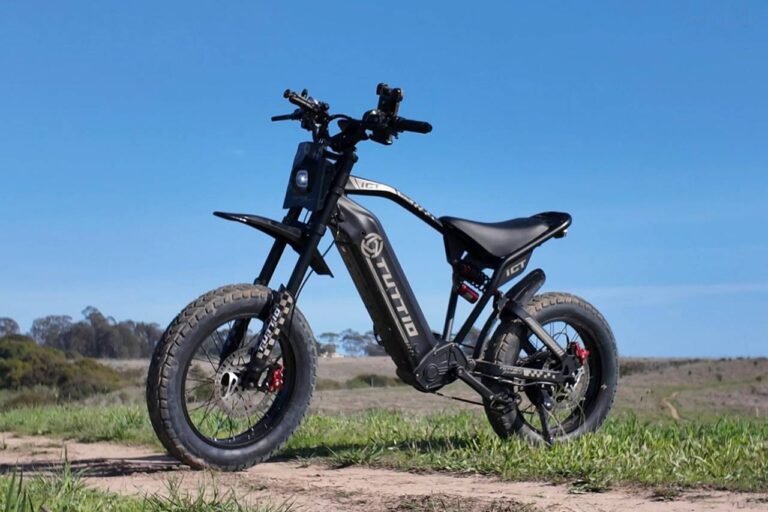
![The 10-Step Checklist Before Buying Your First E-Bike: A Beginner’s Guide ([year]) Checklist Before Buying Your First E-Bike](https://goebikelife.com/wp-content/uploads/2025/06/Checklist-Before-Buying-Your-First-E-Bike-768x512.jpg)
